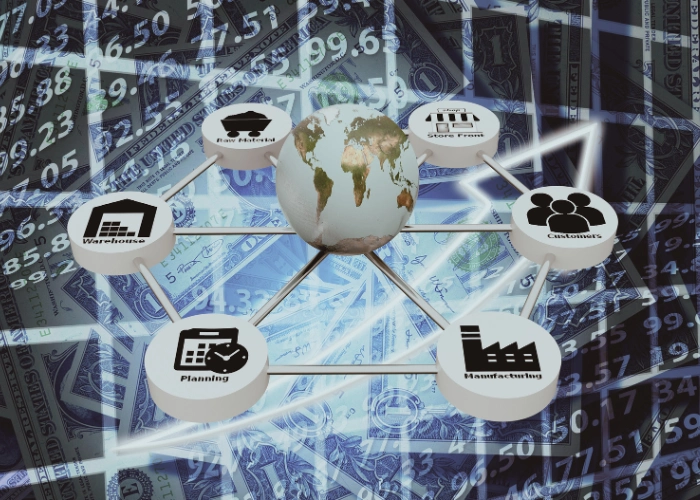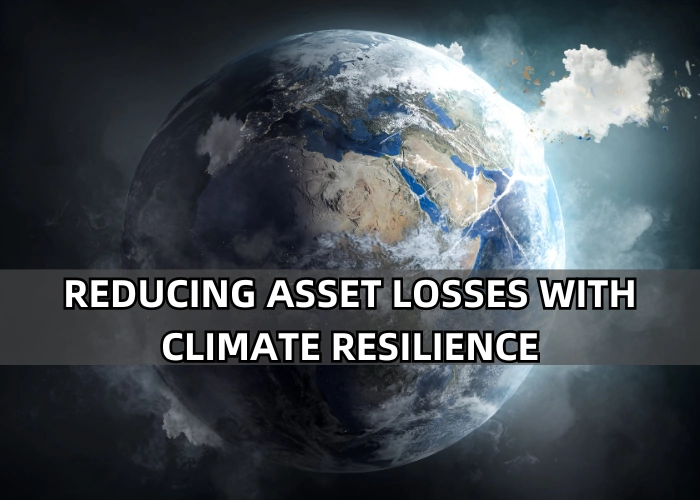Climate resilience is about being ready for and bouncing back from weather surprises. For businesses, this means keeping things running smoothly even when the weather acts up. It’s key because the weather is changing fast.
The National Aeronautics and Space Administration (NASA) explains that human activities are raising levels of greenhouse gasses changing our planet’s climate. This leads to glaciers melting, river and lake ice melting sooner, animals and plants moving to new areas, and earlier blooming of plants and trees.
In other words, places are getting hotter, storms are stronger, and rain can be too much or too little. Buildings and the things we use daily, including in the workplace, might not be ready for these changes. If companies can handle these weather challenges, they can keep their doors open and their workers busy. This is why being climate-resilient is such a big deal—for everyone.
Reducing Asset Losses With Climate Resilience
Climate change can lead to big business losses, from buildings and tools to products. Imagine a flood soaking a factory floor, ruining expensive machines and products waiting to be sold. Or a wildfire getting close to a business, burning the building and everything inside. Even extreme heat can harm tools and goods, rendering them useless.
This happens because the weather is getting more extreme. Storms are stronger, floods are higher, and droughts are longer. These changes can damage or destroy the things a business needs to operate. By being climate-resilient, companies can protect their assets. This means making buildings stronger against storms, moving valuable items to safer places, improving communication infrastructure, and planning ahead for these weather challenges.
Preparation for Changing Laws and Regulations
As the climate changes, so do the rules businesses must follow. One big change comes from the Securities and Exchange Commission (SEC). They’ve set new rules for companies traded in the U.S. stock market.
Under the new SEC rules, companies publicly traded in the U.S. must be much more transparent about how climate change could affect their business. This isn’t just about stating their carbon footprint. Companies need to detail their climate-related goals and the serious climate risks that could really impact their strategies, operations, or finances.
They must explain how they plan to handle these climate risks. This includes sharing the money they’ve spent and the changes they’ve made to dodge these risks. It’s not just about what they’re doing now but also their future plans, like using new tech or changing their business model to lower their climate impact.
Furthermore, the rules dive deep into how a company manages these risks. This includes how the board and management monitor climate issues and incorporate this awareness into their overall risk management.
Bigger companies must also report their direct and energy-related greenhouse gas emissions, with checks from outside the company to ensure everything adds up. After a while, they’ll need even stricter checks.
Lastly, these companies must be upfront about how extreme weather or other natural events could affect their finances. This could mean explaining the costs of damage or the effects on their financial planning. If they’re banking on carbon offsets or renewable energy to hit their climate goals, they must also talk about the financial side of those efforts.

Supply Chain Resilience
We’ve all seen changes to the supply chain in recent years. Items that used to be readily available are now more challenging to find. From raw material shortages to cybercrime, many challenges have tested supply chains’ ability to adapt.
Industries facing high supply chain risks, like Automotive, Manufacturing, Energy, and Retail, need to focus on building resilience. Without doing so, they could jeopardize long-term revenues and consumer loyalty.
Here’s how to start:
- Build Transparency: Knowing every step of your supply chain can reveal risks and opportunities.
- Ask “What If”: Understanding potential vulnerabilities helps prepare for unexpected events.
- Use the Right Tools to Assess Risk: Identifying and analyzing risks is crucial for proactive management.
- Get Ahead of Risks: Implement strategies to lessen the impact of potential disruptions.
- Transfer Risks When It Makes Sense: Sometimes, the best strategy is to share or insure against certain risks.
Streamlined Operations
Making your business climate-resilient goes hand in hand with enhancing operational efficiency and minimizing waste. A primary strategy in this effort is streamlining operations.
Digitization is about shifting from traditional, often paper-based systems to digital platforms. This transition reduces the physical waste associated with paper and streamlines data management and accessibility. With digitization, information can be shared instantaneously and decisions can be made faster.
Improving communication within the organization is another big aspect of streamlining operations. This ensures that every team member stays connected and informed regardless of location. This is where technologies like MOTOTRBO Mobile Radios and MOTOTRBO Portable Radios come into play. These advanced communication tools facilitate immediate communication across different departments and locations.
Fewer Operational Interruptions
In just the last five years, the U.S. has experienced 18 climate-related disasters, resulting in billions of dollars in damage. These natural disasters pose a significant risk to business operations. Floods, hurricanes, and wildfires can halt production, damage infrastructure, and disrupt supply chains. In these scenarios, operational continuity is a non-negotiable way to minimize financial losses and maintain customer trust.
Communication technology is integral in reducing such interruptions. Innovations in two-way radio technology, such as AI integration, extended battery life, and enhanced connectivity, make these investments pay off more than ever before. For example, AI integration enables smarter, automated responses to changing conditions, ensuring critical information reaches the right people at the right time. Longer battery life guarantees communication lines stay open longer, a must during extended outages. Improved connectivity ensures that teams can stay in touch remotely or in an affected area.
Let’s take the transportation industry as an example. During natural disasters, timely updates and rerouting information are necessary. Advanced two-way radios can provide real-time communication between drivers, dispatchers, and emergency management teams, allowing for quick adjustments to routes and schedules. This adaptability minimizes downtime and gets goods from point A to point B.
Reputation Management
Today’s consumers are more discerning than ever. They demand that companies take the necessary steps to protect the environment. In fact, 33% of consumers (if not more) indicate that they prefer to do business with organizations that do social or environmental good.
And, this is where reputation management comes into play. Reputation management is shaping and maintaining how the public perceives a company. As we shared, consumers are increasingly concerned about environmental issues, and how a company responds to climate change can significantly impact its reputation.
Companies can manage their reputations by openly communicating their steps to become more environmentally friendly. This might include initiatives to reduce emissions, efforts to switch to renewable energy sources, or policies to ensure more sustainable supply chains. By sharing these changes through social media, press releases, and sustainability reports, companies can demonstrate their commitment to the environment.
Engaging with customers directly about these efforts can build community and shared values. Companies can host forums, workshops, or webinars to discuss their environmental impact and sustainability goals. This transparent approach enhances a company’s reputation and encourages consumer loyalty, as customers are more likely to support businesses that align with their environmental values.

Safer Communities
Safer and more secure business procedures protect company assets and enhance community safety. Properly storing hazardous materials, designing buildings to withstand natural disasters, and ensuring employees are well-trained in safety protocols prevent accidents that could have wider impacts on the surrounding area. For example, securely maintained chemicals reduce the risk of spills that harm local ecosystems, while resilient building designs can provide shelter during extreme weather events.
Motorola Solutions champions the belief that safety, efficiency, and productivity are closely linked. The company understands that technologies designed to keep us safe should also enhance our ability to perform tasks more effectively. Motorola has created the first ecosystem that unifies safety technologies by integrating voice, video, data, and analytics into a single platform.
This approach addresses current industry challenges and anticipates future needs, ensuring communities benefit from advancements in safety technology.
EMCI Wireless is the Leading Motorola Solutions Partner in Central and South Florida
As your organization works to build climate resilience, EMCI Wireless is here to help you create a technologically advanced communications infrastructure. Like you, we’re committed to improving the world and staying on top of climate change and the resulting needs. Request a free consultation today.






